ICT710: Westfield Case Study on Ethics and IT Governance Framework
VerifiedAdded on 2023/03/31
|12
|3330
|355
Report
AI Summary
This report delves into the information technology activities of Westfield, an Australian shopping center company, focusing on its ethics and IT governance framework. It examines the ethical implications of Westfield's digital transformation, particularly concerning privacy, complex situations, and the elimination of liability. The report highlights how Westfield leveraged digital disruption to connect with digital shoppers and enhance their shopping experience through initiatives like Westfield Labs and various digital storefront technologies. It also discusses the application of the ACS Code of Ethics, emphasizing the importance of public interest, quality of life, honesty, competence, professional development, and professionalism in the ICT industry. The analysis underscores the challenges and opportunities Westfield faces in balancing innovation with ethical considerations, ensuring customer satisfaction, and maintaining a competitive edge in the evolving digital landscape.
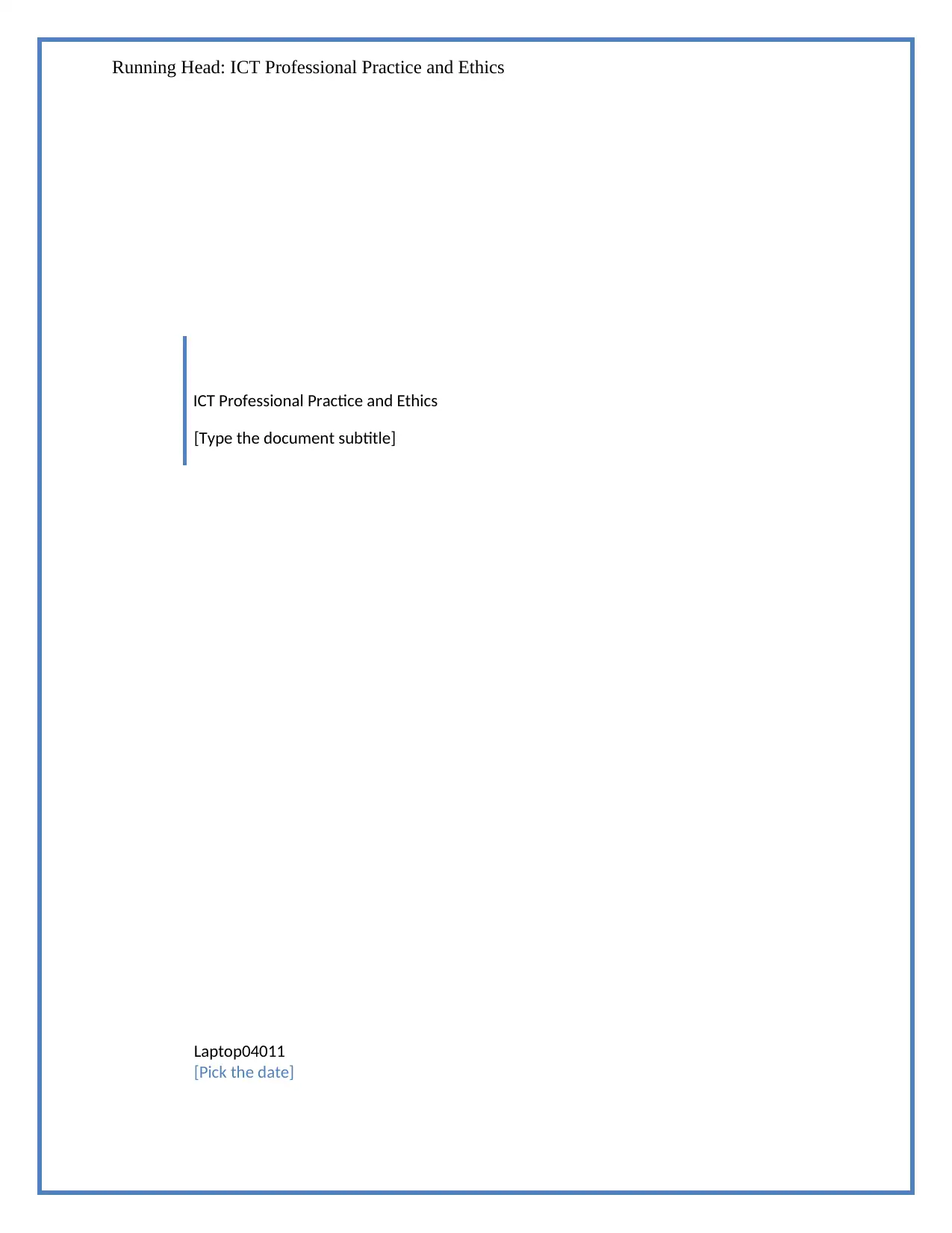
Running Head: ICT Professional Practice and Ethics
ICT Professional Practice and Ethics
[Type the document subtitle]
Laptop04011
[Pick the date]
ICT Professional Practice and Ethics
[Type the document subtitle]
Laptop04011
[Pick the date]
Paraphrase This Document
Need a fresh take? Get an instant paraphrase of this document with our AI Paraphraser
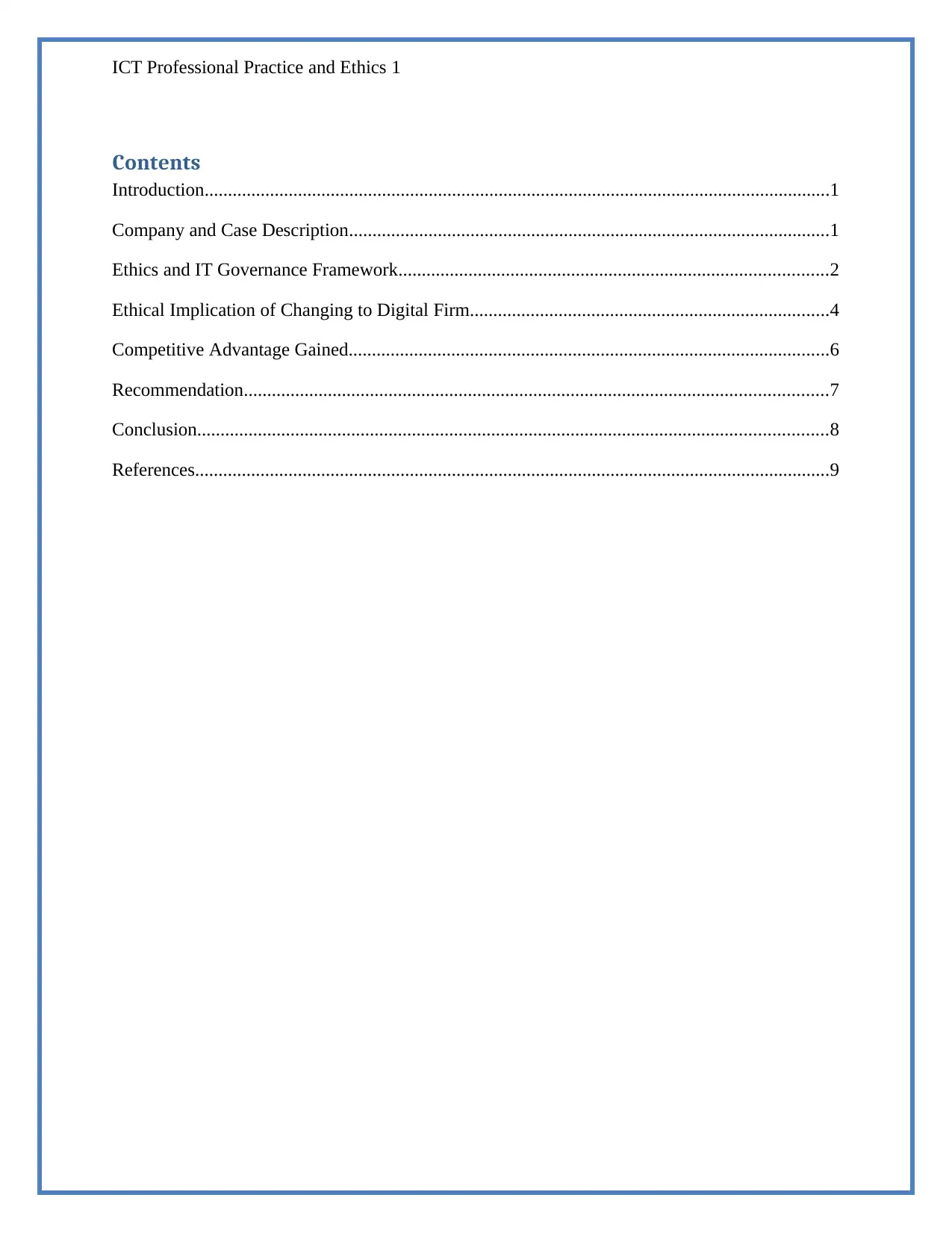
ICT Professional Practice and Ethics 1
Contents
Introduction......................................................................................................................................1
Company and Case Description.......................................................................................................1
Ethics and IT Governance Framework............................................................................................2
Ethical Implication of Changing to Digital Firm.............................................................................4
Competitive Advantage Gained.......................................................................................................6
Recommendation.............................................................................................................................7
Conclusion.......................................................................................................................................8
References........................................................................................................................................9
Contents
Introduction......................................................................................................................................1
Company and Case Description.......................................................................................................1
Ethics and IT Governance Framework............................................................................................2
Ethical Implication of Changing to Digital Firm.............................................................................4
Competitive Advantage Gained.......................................................................................................6
Recommendation.............................................................................................................................7
Conclusion.......................................................................................................................................8
References........................................................................................................................................9
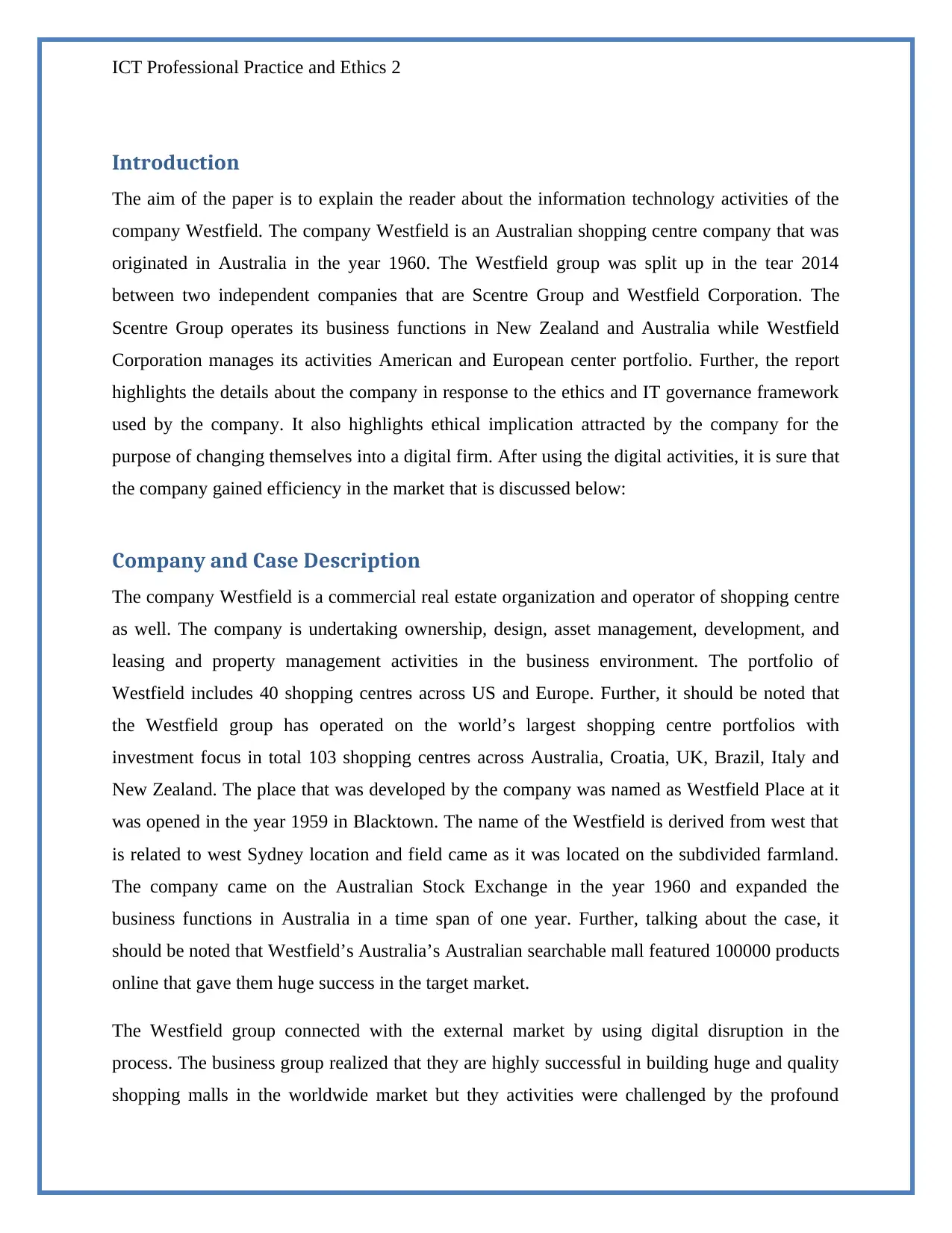
ICT Professional Practice and Ethics 2
Introduction
The aim of the paper is to explain the reader about the information technology activities of the
company Westfield. The company Westfield is an Australian shopping centre company that was
originated in Australia in the year 1960. The Westfield group was split up in the tear 2014
between two independent companies that are Scentre Group and Westfield Corporation. The
Scentre Group operates its business functions in New Zealand and Australia while Westfield
Corporation manages its activities American and European center portfolio. Further, the report
highlights the details about the company in response to the ethics and IT governance framework
used by the company. It also highlights ethical implication attracted by the company for the
purpose of changing themselves into a digital firm. After using the digital activities, it is sure that
the company gained efficiency in the market that is discussed below:
Company and Case Description
The company Westfield is a commercial real estate organization and operator of shopping centre
as well. The company is undertaking ownership, design, asset management, development, and
leasing and property management activities in the business environment. The portfolio of
Westfield includes 40 shopping centres across US and Europe. Further, it should be noted that
the Westfield group has operated on the world’s largest shopping centre portfolios with
investment focus in total 103 shopping centres across Australia, Croatia, UK, Brazil, Italy and
New Zealand. The place that was developed by the company was named as Westfield Place at it
was opened in the year 1959 in Blacktown. The name of the Westfield is derived from west that
is related to west Sydney location and field came as it was located on the subdivided farmland.
The company came on the Australian Stock Exchange in the year 1960 and expanded the
business functions in Australia in a time span of one year. Further, talking about the case, it
should be noted that Westfield’s Australia’s Australian searchable mall featured 100000 products
online that gave them huge success in the target market.
The Westfield group connected with the external market by using digital disruption in the
process. The business group realized that they are highly successful in building huge and quality
shopping malls in the worldwide market but they activities were challenged by the profound
Introduction
The aim of the paper is to explain the reader about the information technology activities of the
company Westfield. The company Westfield is an Australian shopping centre company that was
originated in Australia in the year 1960. The Westfield group was split up in the tear 2014
between two independent companies that are Scentre Group and Westfield Corporation. The
Scentre Group operates its business functions in New Zealand and Australia while Westfield
Corporation manages its activities American and European center portfolio. Further, the report
highlights the details about the company in response to the ethics and IT governance framework
used by the company. It also highlights ethical implication attracted by the company for the
purpose of changing themselves into a digital firm. After using the digital activities, it is sure that
the company gained efficiency in the market that is discussed below:
Company and Case Description
The company Westfield is a commercial real estate organization and operator of shopping centre
as well. The company is undertaking ownership, design, asset management, development, and
leasing and property management activities in the business environment. The portfolio of
Westfield includes 40 shopping centres across US and Europe. Further, it should be noted that
the Westfield group has operated on the world’s largest shopping centre portfolios with
investment focus in total 103 shopping centres across Australia, Croatia, UK, Brazil, Italy and
New Zealand. The place that was developed by the company was named as Westfield Place at it
was opened in the year 1959 in Blacktown. The name of the Westfield is derived from west that
is related to west Sydney location and field came as it was located on the subdivided farmland.
The company came on the Australian Stock Exchange in the year 1960 and expanded the
business functions in Australia in a time span of one year. Further, talking about the case, it
should be noted that Westfield’s Australia’s Australian searchable mall featured 100000 products
online that gave them huge success in the target market.
The Westfield group connected with the external market by using digital disruption in the
process. The business group realized that they are highly successful in building huge and quality
shopping malls in the worldwide market but they activities were challenged by the profound
⊘ This is a preview!⊘
Do you want full access?
Subscribe today to unlock all pages.

Trusted by 1+ million students worldwide
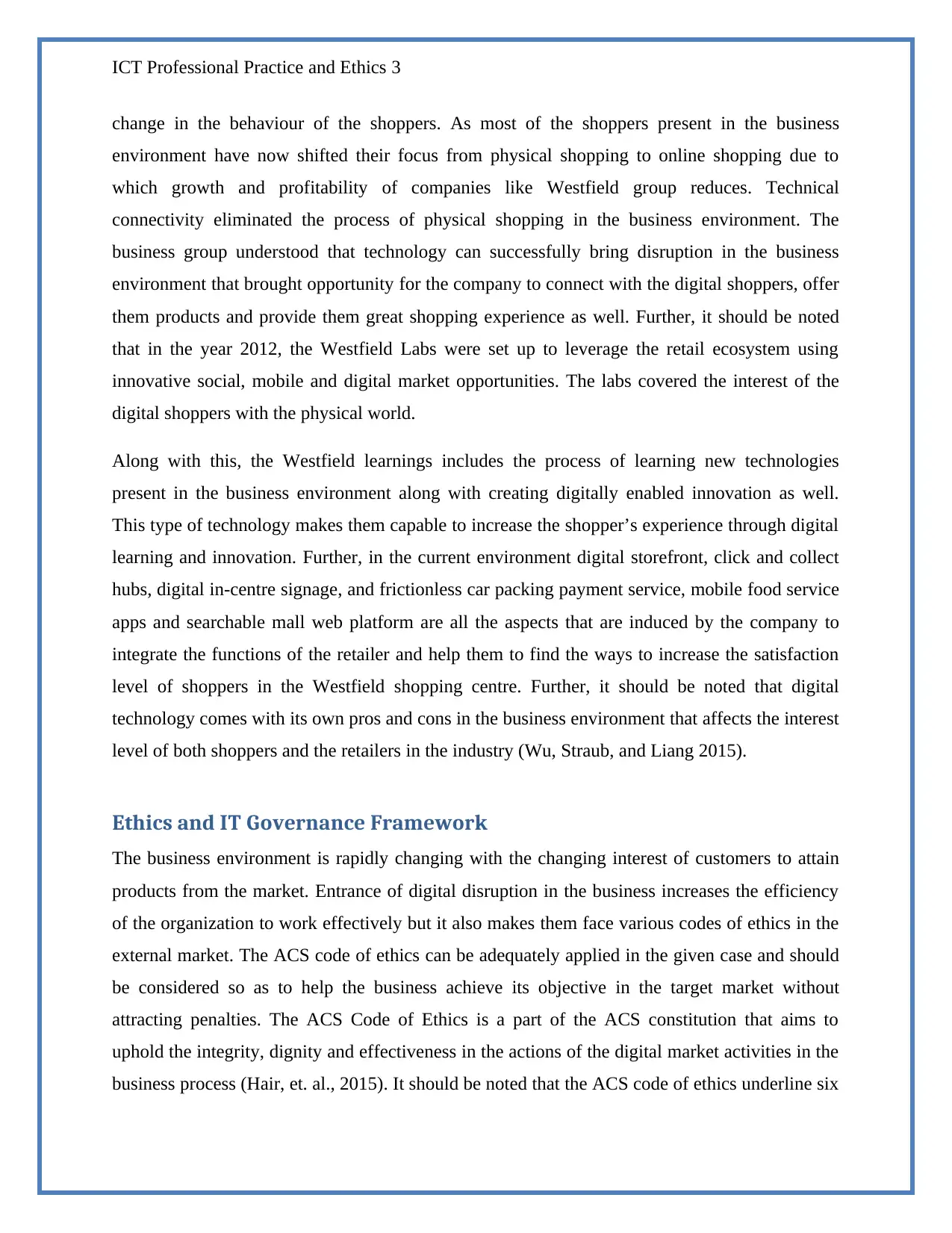
ICT Professional Practice and Ethics 3
change in the behaviour of the shoppers. As most of the shoppers present in the business
environment have now shifted their focus from physical shopping to online shopping due to
which growth and profitability of companies like Westfield group reduces. Technical
connectivity eliminated the process of physical shopping in the business environment. The
business group understood that technology can successfully bring disruption in the business
environment that brought opportunity for the company to connect with the digital shoppers, offer
them products and provide them great shopping experience as well. Further, it should be noted
that in the year 2012, the Westfield Labs were set up to leverage the retail ecosystem using
innovative social, mobile and digital market opportunities. The labs covered the interest of the
digital shoppers with the physical world.
Along with this, the Westfield learnings includes the process of learning new technologies
present in the business environment along with creating digitally enabled innovation as well.
This type of technology makes them capable to increase the shopper’s experience through digital
learning and innovation. Further, in the current environment digital storefront, click and collect
hubs, digital in-centre signage, and frictionless car packing payment service, mobile food service
apps and searchable mall web platform are all the aspects that are induced by the company to
integrate the functions of the retailer and help them to find the ways to increase the satisfaction
level of shoppers in the Westfield shopping centre. Further, it should be noted that digital
technology comes with its own pros and cons in the business environment that affects the interest
level of both shoppers and the retailers in the industry (Wu, Straub, and Liang 2015).
Ethics and IT Governance Framework
The business environment is rapidly changing with the changing interest of customers to attain
products from the market. Entrance of digital disruption in the business increases the efficiency
of the organization to work effectively but it also makes them face various codes of ethics in the
external market. The ACS code of ethics can be adequately applied in the given case and should
be considered so as to help the business achieve its objective in the target market without
attracting penalties. The ACS Code of Ethics is a part of the ACS constitution that aims to
uphold the integrity, dignity and effectiveness in the actions of the digital market activities in the
business process (Hair, et. al., 2015). It should be noted that the ACS code of ethics underline six
change in the behaviour of the shoppers. As most of the shoppers present in the business
environment have now shifted their focus from physical shopping to online shopping due to
which growth and profitability of companies like Westfield group reduces. Technical
connectivity eliminated the process of physical shopping in the business environment. The
business group understood that technology can successfully bring disruption in the business
environment that brought opportunity for the company to connect with the digital shoppers, offer
them products and provide them great shopping experience as well. Further, it should be noted
that in the year 2012, the Westfield Labs were set up to leverage the retail ecosystem using
innovative social, mobile and digital market opportunities. The labs covered the interest of the
digital shoppers with the physical world.
Along with this, the Westfield learnings includes the process of learning new technologies
present in the business environment along with creating digitally enabled innovation as well.
This type of technology makes them capable to increase the shopper’s experience through digital
learning and innovation. Further, in the current environment digital storefront, click and collect
hubs, digital in-centre signage, and frictionless car packing payment service, mobile food service
apps and searchable mall web platform are all the aspects that are induced by the company to
integrate the functions of the retailer and help them to find the ways to increase the satisfaction
level of shoppers in the Westfield shopping centre. Further, it should be noted that digital
technology comes with its own pros and cons in the business environment that affects the interest
level of both shoppers and the retailers in the industry (Wu, Straub, and Liang 2015).
Ethics and IT Governance Framework
The business environment is rapidly changing with the changing interest of customers to attain
products from the market. Entrance of digital disruption in the business increases the efficiency
of the organization to work effectively but it also makes them face various codes of ethics in the
external market. The ACS code of ethics can be adequately applied in the given case and should
be considered so as to help the business achieve its objective in the target market without
attracting penalties. The ACS Code of Ethics is a part of the ACS constitution that aims to
uphold the integrity, dignity and effectiveness in the actions of the digital market activities in the
business process (Hair, et. al., 2015). It should be noted that the ACS code of ethics underline six
Paraphrase This Document
Need a fresh take? Get an instant paraphrase of this document with our AI Paraphraser
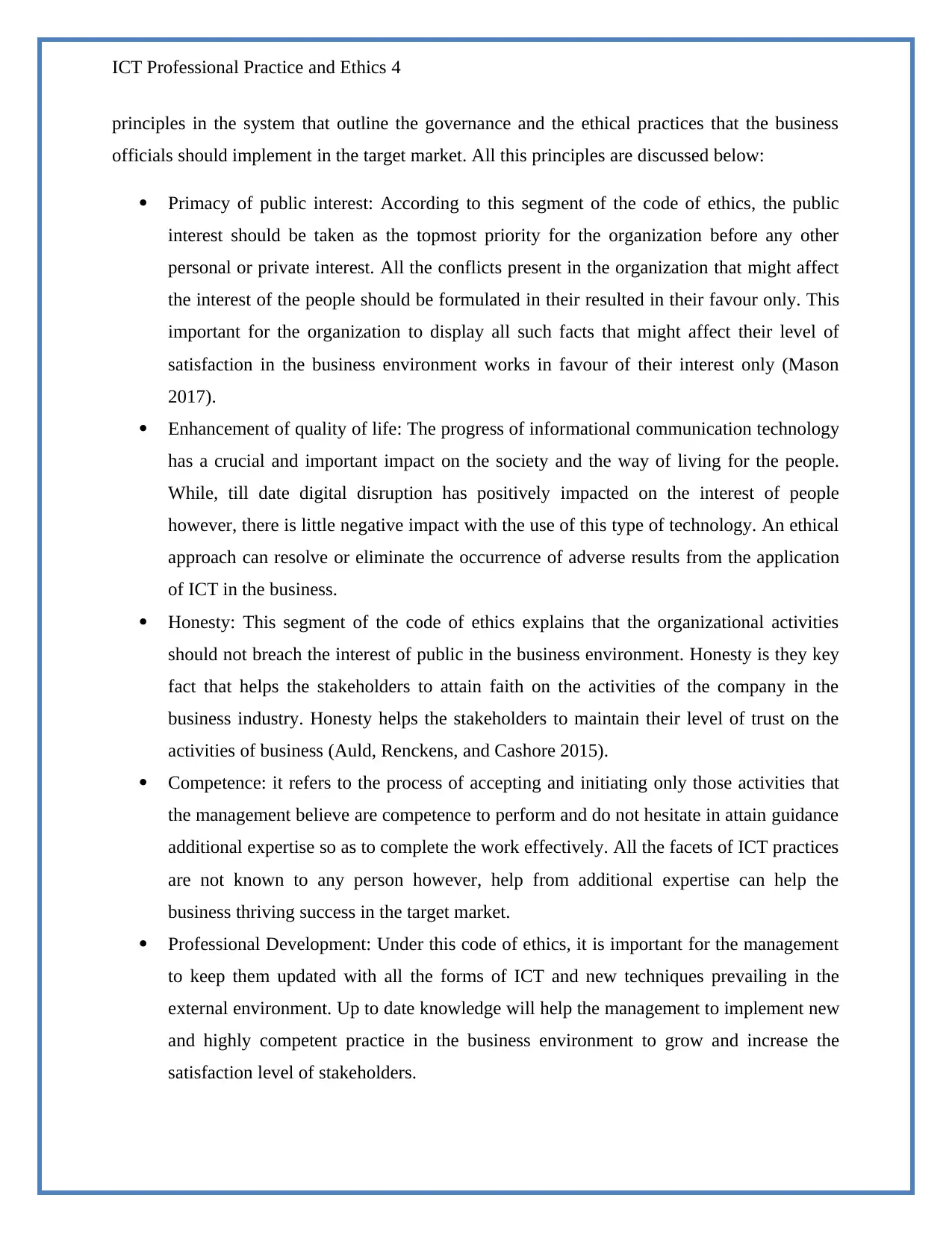
ICT Professional Practice and Ethics 4
principles in the system that outline the governance and the ethical practices that the business
officials should implement in the target market. All this principles are discussed below:
Primacy of public interest: According to this segment of the code of ethics, the public
interest should be taken as the topmost priority for the organization before any other
personal or private interest. All the conflicts present in the organization that might affect
the interest of the people should be formulated in their resulted in their favour only. This
important for the organization to display all such facts that might affect their level of
satisfaction in the business environment works in favour of their interest only (Mason
2017).
Enhancement of quality of life: The progress of informational communication technology
has a crucial and important impact on the society and the way of living for the people.
While, till date digital disruption has positively impacted on the interest of people
however, there is little negative impact with the use of this type of technology. An ethical
approach can resolve or eliminate the occurrence of adverse results from the application
of ICT in the business.
Honesty: This segment of the code of ethics explains that the organizational activities
should not breach the interest of public in the business environment. Honesty is they key
fact that helps the stakeholders to attain faith on the activities of the company in the
business industry. Honesty helps the stakeholders to maintain their level of trust on the
activities of business (Auld, Renckens, and Cashore 2015).
Competence: it refers to the process of accepting and initiating only those activities that
the management believe are competence to perform and do not hesitate in attain guidance
additional expertise so as to complete the work effectively. All the facets of ICT practices
are not known to any person however, help from additional expertise can help the
business thriving success in the target market.
Professional Development: Under this code of ethics, it is important for the management
to keep them updated with all the forms of ICT and new techniques prevailing in the
external environment. Up to date knowledge will help the management to implement new
and highly competent practice in the business environment to grow and increase the
satisfaction level of stakeholders.
principles in the system that outline the governance and the ethical practices that the business
officials should implement in the target market. All this principles are discussed below:
Primacy of public interest: According to this segment of the code of ethics, the public
interest should be taken as the topmost priority for the organization before any other
personal or private interest. All the conflicts present in the organization that might affect
the interest of the people should be formulated in their resulted in their favour only. This
important for the organization to display all such facts that might affect their level of
satisfaction in the business environment works in favour of their interest only (Mason
2017).
Enhancement of quality of life: The progress of informational communication technology
has a crucial and important impact on the society and the way of living for the people.
While, till date digital disruption has positively impacted on the interest of people
however, there is little negative impact with the use of this type of technology. An ethical
approach can resolve or eliminate the occurrence of adverse results from the application
of ICT in the business.
Honesty: This segment of the code of ethics explains that the organizational activities
should not breach the interest of public in the business environment. Honesty is they key
fact that helps the stakeholders to attain faith on the activities of the company in the
business industry. Honesty helps the stakeholders to maintain their level of trust on the
activities of business (Auld, Renckens, and Cashore 2015).
Competence: it refers to the process of accepting and initiating only those activities that
the management believe are competence to perform and do not hesitate in attain guidance
additional expertise so as to complete the work effectively. All the facets of ICT practices
are not known to any person however, help from additional expertise can help the
business thriving success in the target market.
Professional Development: Under this code of ethics, it is important for the management
to keep them updated with all the forms of ICT and new techniques prevailing in the
external environment. Up to date knowledge will help the management to implement new
and highly competent practice in the business environment to grow and increase the
satisfaction level of stakeholders.
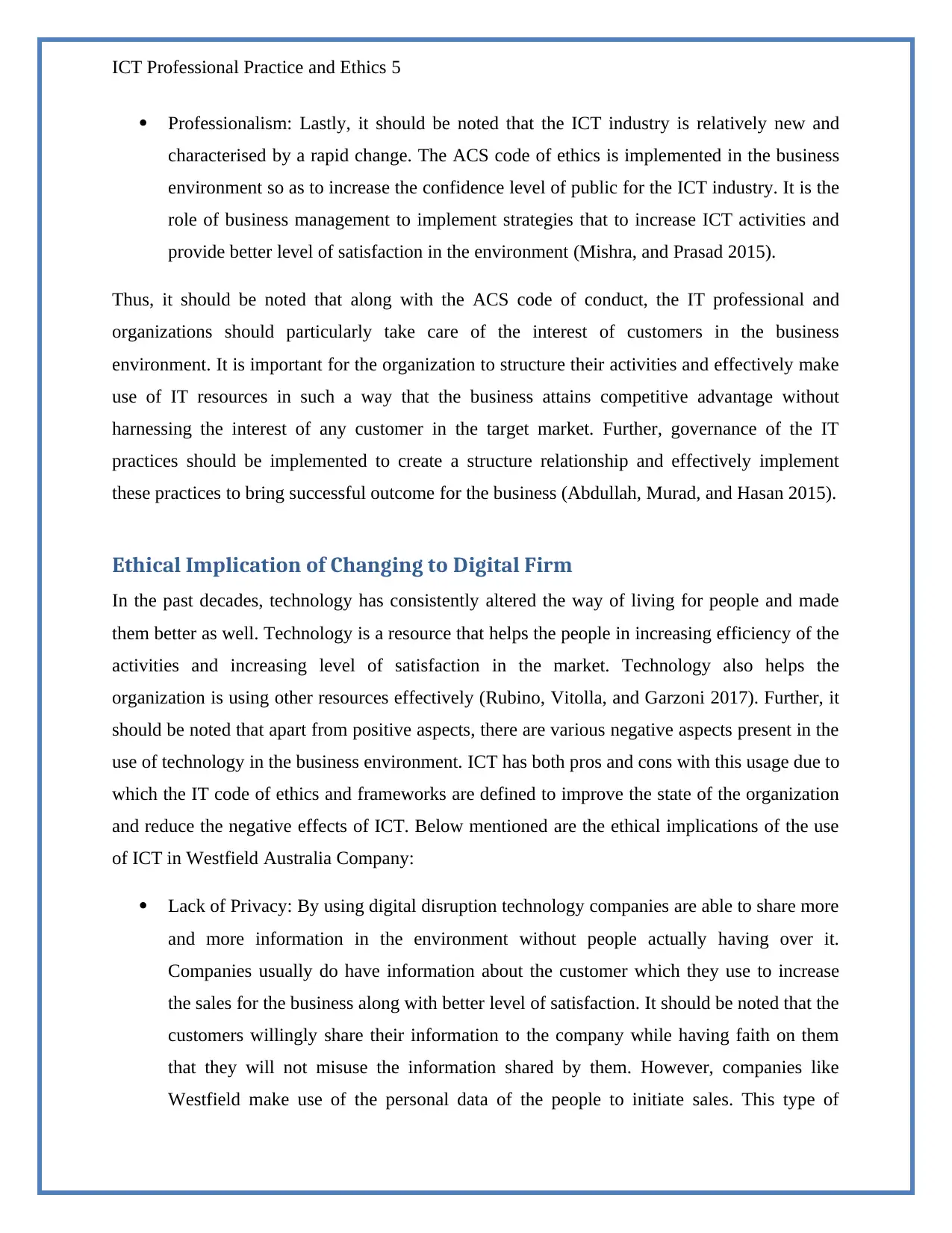
ICT Professional Practice and Ethics 5
Professionalism: Lastly, it should be noted that the ICT industry is relatively new and
characterised by a rapid change. The ACS code of ethics is implemented in the business
environment so as to increase the confidence level of public for the ICT industry. It is the
role of business management to implement strategies that to increase ICT activities and
provide better level of satisfaction in the environment (Mishra, and Prasad 2015).
Thus, it should be noted that along with the ACS code of conduct, the IT professional and
organizations should particularly take care of the interest of customers in the business
environment. It is important for the organization to structure their activities and effectively make
use of IT resources in such a way that the business attains competitive advantage without
harnessing the interest of any customer in the target market. Further, governance of the IT
practices should be implemented to create a structure relationship and effectively implement
these practices to bring successful outcome for the business (Abdullah, Murad, and Hasan 2015).
Ethical Implication of Changing to Digital Firm
In the past decades, technology has consistently altered the way of living for people and made
them better as well. Technology is a resource that helps the people in increasing efficiency of the
activities and increasing level of satisfaction in the market. Technology also helps the
organization is using other resources effectively (Rubino, Vitolla, and Garzoni 2017). Further, it
should be noted that apart from positive aspects, there are various negative aspects present in the
use of technology in the business environment. ICT has both pros and cons with this usage due to
which the IT code of ethics and frameworks are defined to improve the state of the organization
and reduce the negative effects of ICT. Below mentioned are the ethical implications of the use
of ICT in Westfield Australia Company:
Lack of Privacy: By using digital disruption technology companies are able to share more
and more information in the environment without people actually having over it.
Companies usually do have information about the customer which they use to increase
the sales for the business along with better level of satisfaction. It should be noted that the
customers willingly share their information to the company while having faith on them
that they will not misuse the information shared by them. However, companies like
Westfield make use of the personal data of the people to initiate sales. This type of
Professionalism: Lastly, it should be noted that the ICT industry is relatively new and
characterised by a rapid change. The ACS code of ethics is implemented in the business
environment so as to increase the confidence level of public for the ICT industry. It is the
role of business management to implement strategies that to increase ICT activities and
provide better level of satisfaction in the environment (Mishra, and Prasad 2015).
Thus, it should be noted that along with the ACS code of conduct, the IT professional and
organizations should particularly take care of the interest of customers in the business
environment. It is important for the organization to structure their activities and effectively make
use of IT resources in such a way that the business attains competitive advantage without
harnessing the interest of any customer in the target market. Further, governance of the IT
practices should be implemented to create a structure relationship and effectively implement
these practices to bring successful outcome for the business (Abdullah, Murad, and Hasan 2015).
Ethical Implication of Changing to Digital Firm
In the past decades, technology has consistently altered the way of living for people and made
them better as well. Technology is a resource that helps the people in increasing efficiency of the
activities and increasing level of satisfaction in the market. Technology also helps the
organization is using other resources effectively (Rubino, Vitolla, and Garzoni 2017). Further, it
should be noted that apart from positive aspects, there are various negative aspects present in the
use of technology in the business environment. ICT has both pros and cons with this usage due to
which the IT code of ethics and frameworks are defined to improve the state of the organization
and reduce the negative effects of ICT. Below mentioned are the ethical implications of the use
of ICT in Westfield Australia Company:
Lack of Privacy: By using digital disruption technology companies are able to share more
and more information in the environment without people actually having over it.
Companies usually do have information about the customer which they use to increase
the sales for the business along with better level of satisfaction. It should be noted that the
customers willingly share their information to the company while having faith on them
that they will not misuse the information shared by them. However, companies like
Westfield make use of the personal data of the people to initiate sales. This type of
⊘ This is a preview!⊘
Do you want full access?
Subscribe today to unlock all pages.

Trusted by 1+ million students worldwide
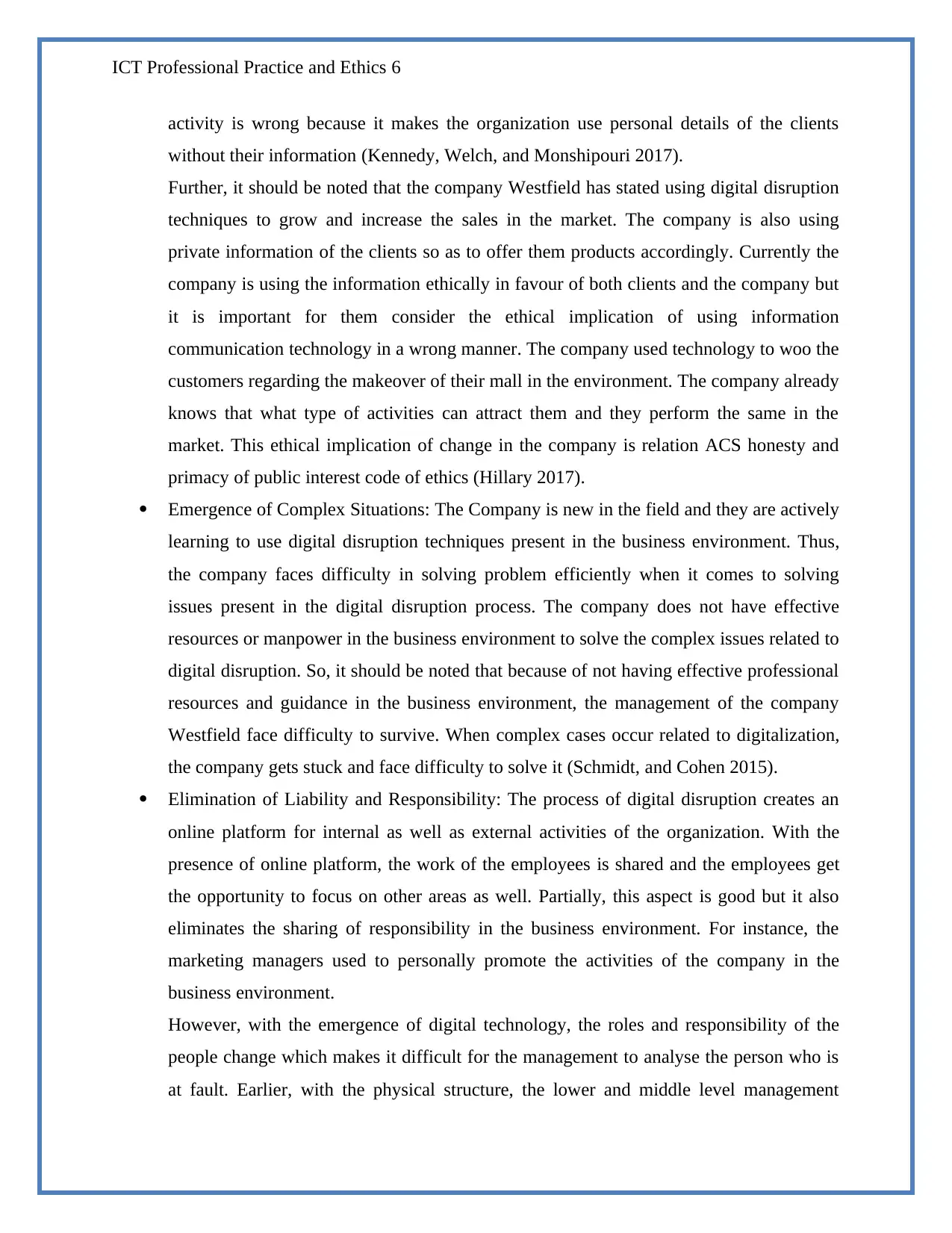
ICT Professional Practice and Ethics 6
activity is wrong because it makes the organization use personal details of the clients
without their information (Kennedy, Welch, and Monshipouri 2017).
Further, it should be noted that the company Westfield has stated using digital disruption
techniques to grow and increase the sales in the market. The company is also using
private information of the clients so as to offer them products accordingly. Currently the
company is using the information ethically in favour of both clients and the company but
it is important for them consider the ethical implication of using information
communication technology in a wrong manner. The company used technology to woo the
customers regarding the makeover of their mall in the environment. The company already
knows that what type of activities can attract them and they perform the same in the
market. This ethical implication of change in the company is relation ACS honesty and
primacy of public interest code of ethics (Hillary 2017).
Emergence of Complex Situations: The Company is new in the field and they are actively
learning to use digital disruption techniques present in the business environment. Thus,
the company faces difficulty in solving problem efficiently when it comes to solving
issues present in the digital disruption process. The company does not have effective
resources or manpower in the business environment to solve the complex issues related to
digital disruption. So, it should be noted that because of not having effective professional
resources and guidance in the business environment, the management of the company
Westfield face difficulty to survive. When complex cases occur related to digitalization,
the company gets stuck and face difficulty to solve it (Schmidt, and Cohen 2015).
Elimination of Liability and Responsibility: The process of digital disruption creates an
online platform for internal as well as external activities of the organization. With the
presence of online platform, the work of the employees is shared and the employees get
the opportunity to focus on other areas as well. Partially, this aspect is good but it also
eliminates the sharing of responsibility in the business environment. For instance, the
marketing managers used to personally promote the activities of the company in the
business environment.
However, with the emergence of digital technology, the roles and responsibility of the
people change which makes it difficult for the management to analyse the person who is
at fault. Earlier, with the physical structure, the lower and middle level management
activity is wrong because it makes the organization use personal details of the clients
without their information (Kennedy, Welch, and Monshipouri 2017).
Further, it should be noted that the company Westfield has stated using digital disruption
techniques to grow and increase the sales in the market. The company is also using
private information of the clients so as to offer them products accordingly. Currently the
company is using the information ethically in favour of both clients and the company but
it is important for them consider the ethical implication of using information
communication technology in a wrong manner. The company used technology to woo the
customers regarding the makeover of their mall in the environment. The company already
knows that what type of activities can attract them and they perform the same in the
market. This ethical implication of change in the company is relation ACS honesty and
primacy of public interest code of ethics (Hillary 2017).
Emergence of Complex Situations: The Company is new in the field and they are actively
learning to use digital disruption techniques present in the business environment. Thus,
the company faces difficulty in solving problem efficiently when it comes to solving
issues present in the digital disruption process. The company does not have effective
resources or manpower in the business environment to solve the complex issues related to
digital disruption. So, it should be noted that because of not having effective professional
resources and guidance in the business environment, the management of the company
Westfield face difficulty to survive. When complex cases occur related to digitalization,
the company gets stuck and face difficulty to solve it (Schmidt, and Cohen 2015).
Elimination of Liability and Responsibility: The process of digital disruption creates an
online platform for internal as well as external activities of the organization. With the
presence of online platform, the work of the employees is shared and the employees get
the opportunity to focus on other areas as well. Partially, this aspect is good but it also
eliminates the sharing of responsibility in the business environment. For instance, the
marketing managers used to personally promote the activities of the company in the
business environment.
However, with the emergence of digital technology, the roles and responsibility of the
people change which makes it difficult for the management to analyse the person who is
at fault. Earlier, with the physical structure, the lower and middle level management
Paraphrase This Document
Need a fresh take? Get an instant paraphrase of this document with our AI Paraphraser
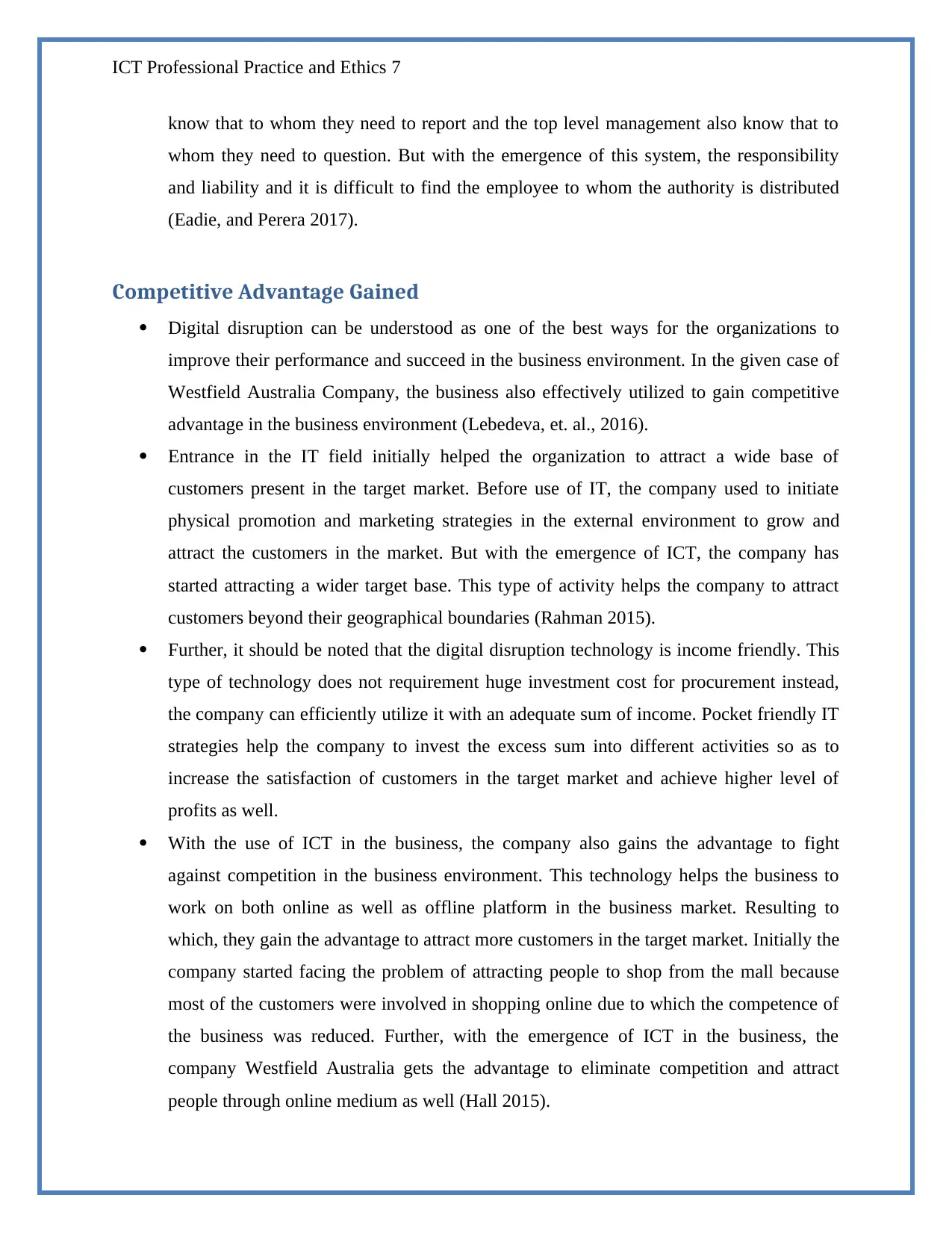
ICT Professional Practice and Ethics 7
know that to whom they need to report and the top level management also know that to
whom they need to question. But with the emergence of this system, the responsibility
and liability and it is difficult to find the employee to whom the authority is distributed
(Eadie, and Perera 2017).
Competitive Advantage Gained
Digital disruption can be understood as one of the best ways for the organizations to
improve their performance and succeed in the business environment. In the given case of
Westfield Australia Company, the business also effectively utilized to gain competitive
advantage in the business environment (Lebedeva, et. al., 2016).
Entrance in the IT field initially helped the organization to attract a wide base of
customers present in the target market. Before use of IT, the company used to initiate
physical promotion and marketing strategies in the external environment to grow and
attract the customers in the market. But with the emergence of ICT, the company has
started attracting a wider target base. This type of activity helps the company to attract
customers beyond their geographical boundaries (Rahman 2015).
Further, it should be noted that the digital disruption technology is income friendly. This
type of technology does not requirement huge investment cost for procurement instead,
the company can efficiently utilize it with an adequate sum of income. Pocket friendly IT
strategies help the company to invest the excess sum into different activities so as to
increase the satisfaction of customers in the target market and achieve higher level of
profits as well.
With the use of ICT in the business, the company also gains the advantage to fight
against competition in the business environment. This technology helps the business to
work on both online as well as offline platform in the business market. Resulting to
which, they gain the advantage to attract more customers in the target market. Initially the
company started facing the problem of attracting people to shop from the mall because
most of the customers were involved in shopping online due to which the competence of
the business was reduced. Further, with the emergence of ICT in the business, the
company Westfield Australia gets the advantage to eliminate competition and attract
people through online medium as well (Hall 2015).
know that to whom they need to report and the top level management also know that to
whom they need to question. But with the emergence of this system, the responsibility
and liability and it is difficult to find the employee to whom the authority is distributed
(Eadie, and Perera 2017).
Competitive Advantage Gained
Digital disruption can be understood as one of the best ways for the organizations to
improve their performance and succeed in the business environment. In the given case of
Westfield Australia Company, the business also effectively utilized to gain competitive
advantage in the business environment (Lebedeva, et. al., 2016).
Entrance in the IT field initially helped the organization to attract a wide base of
customers present in the target market. Before use of IT, the company used to initiate
physical promotion and marketing strategies in the external environment to grow and
attract the customers in the market. But with the emergence of ICT, the company has
started attracting a wider target base. This type of activity helps the company to attract
customers beyond their geographical boundaries (Rahman 2015).
Further, it should be noted that the digital disruption technology is income friendly. This
type of technology does not requirement huge investment cost for procurement instead,
the company can efficiently utilize it with an adequate sum of income. Pocket friendly IT
strategies help the company to invest the excess sum into different activities so as to
increase the satisfaction of customers in the target market and achieve higher level of
profits as well.
With the use of ICT in the business, the company also gains the advantage to fight
against competition in the business environment. This technology helps the business to
work on both online as well as offline platform in the business market. Resulting to
which, they gain the advantage to attract more customers in the target market. Initially the
company started facing the problem of attracting people to shop from the mall because
most of the customers were involved in shopping online due to which the competence of
the business was reduced. Further, with the emergence of ICT in the business, the
company Westfield Australia gets the advantage to eliminate competition and attract
people through online medium as well (Hall 2015).
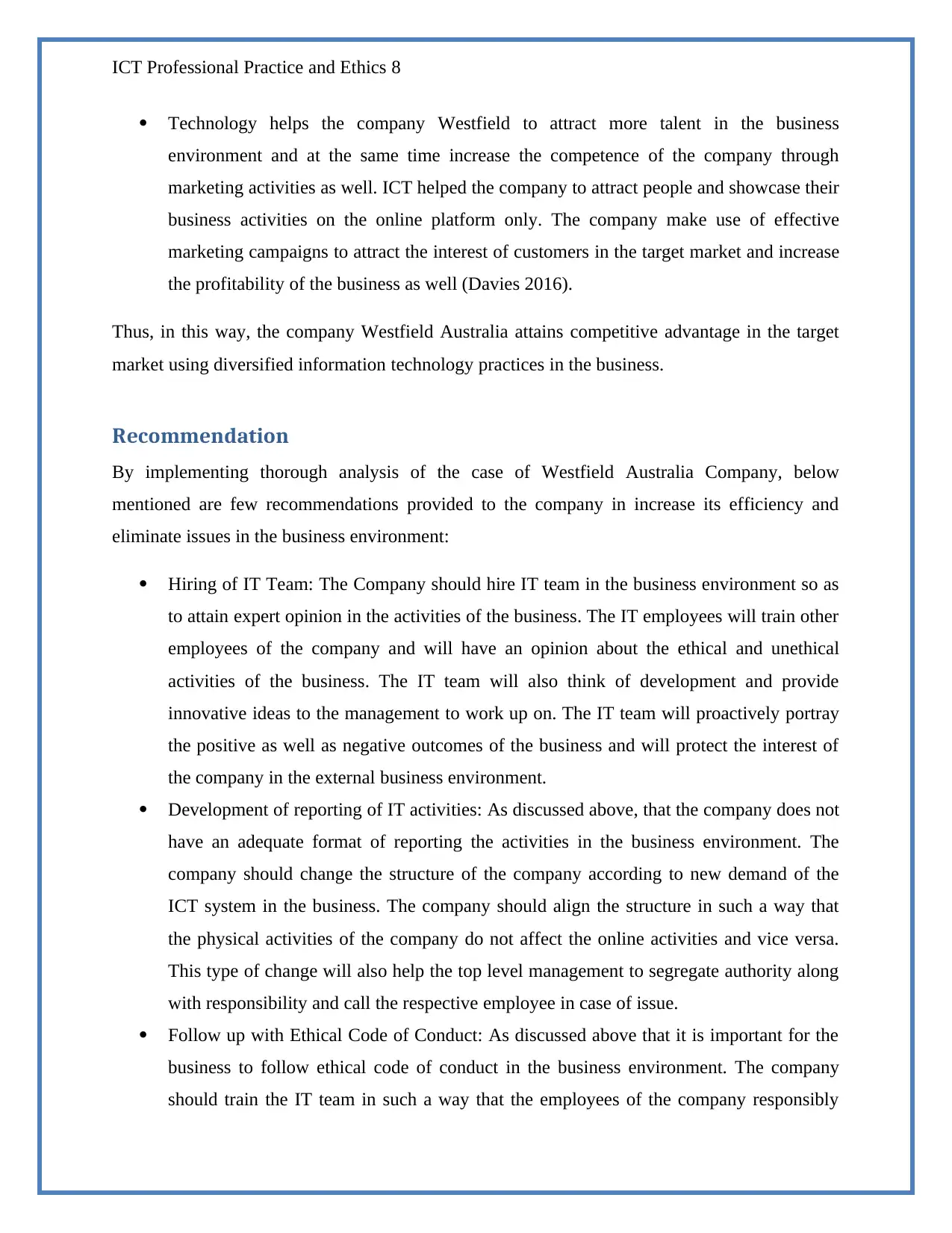
ICT Professional Practice and Ethics 8
Technology helps the company Westfield to attract more talent in the business
environment and at the same time increase the competence of the company through
marketing activities as well. ICT helped the company to attract people and showcase their
business activities on the online platform only. The company make use of effective
marketing campaigns to attract the interest of customers in the target market and increase
the profitability of the business as well (Davies 2016).
Thus, in this way, the company Westfield Australia attains competitive advantage in the target
market using diversified information technology practices in the business.
Recommendation
By implementing thorough analysis of the case of Westfield Australia Company, below
mentioned are few recommendations provided to the company in increase its efficiency and
eliminate issues in the business environment:
Hiring of IT Team: The Company should hire IT team in the business environment so as
to attain expert opinion in the activities of the business. The IT employees will train other
employees of the company and will have an opinion about the ethical and unethical
activities of the business. The IT team will also think of development and provide
innovative ideas to the management to work up on. The IT team will proactively portray
the positive as well as negative outcomes of the business and will protect the interest of
the company in the external business environment.
Development of reporting of IT activities: As discussed above, that the company does not
have an adequate format of reporting the activities in the business environment. The
company should change the structure of the company according to new demand of the
ICT system in the business. The company should align the structure in such a way that
the physical activities of the company do not affect the online activities and vice versa.
This type of change will also help the top level management to segregate authority along
with responsibility and call the respective employee in case of issue.
Follow up with Ethical Code of Conduct: As discussed above that it is important for the
business to follow ethical code of conduct in the business environment. The company
should train the IT team in such a way that the employees of the company responsibly
Technology helps the company Westfield to attract more talent in the business
environment and at the same time increase the competence of the company through
marketing activities as well. ICT helped the company to attract people and showcase their
business activities on the online platform only. The company make use of effective
marketing campaigns to attract the interest of customers in the target market and increase
the profitability of the business as well (Davies 2016).
Thus, in this way, the company Westfield Australia attains competitive advantage in the target
market using diversified information technology practices in the business.
Recommendation
By implementing thorough analysis of the case of Westfield Australia Company, below
mentioned are few recommendations provided to the company in increase its efficiency and
eliminate issues in the business environment:
Hiring of IT Team: The Company should hire IT team in the business environment so as
to attain expert opinion in the activities of the business. The IT employees will train other
employees of the company and will have an opinion about the ethical and unethical
activities of the business. The IT team will also think of development and provide
innovative ideas to the management to work up on. The IT team will proactively portray
the positive as well as negative outcomes of the business and will protect the interest of
the company in the external business environment.
Development of reporting of IT activities: As discussed above, that the company does not
have an adequate format of reporting the activities in the business environment. The
company should change the structure of the company according to new demand of the
ICT system in the business. The company should align the structure in such a way that
the physical activities of the company do not affect the online activities and vice versa.
This type of change will also help the top level management to segregate authority along
with responsibility and call the respective employee in case of issue.
Follow up with Ethical Code of Conduct: As discussed above that it is important for the
business to follow ethical code of conduct in the business environment. The company
should train the IT team in such a way that the employees of the company responsibly
⊘ This is a preview!⊘
Do you want full access?
Subscribe today to unlock all pages.

Trusted by 1+ million students worldwide
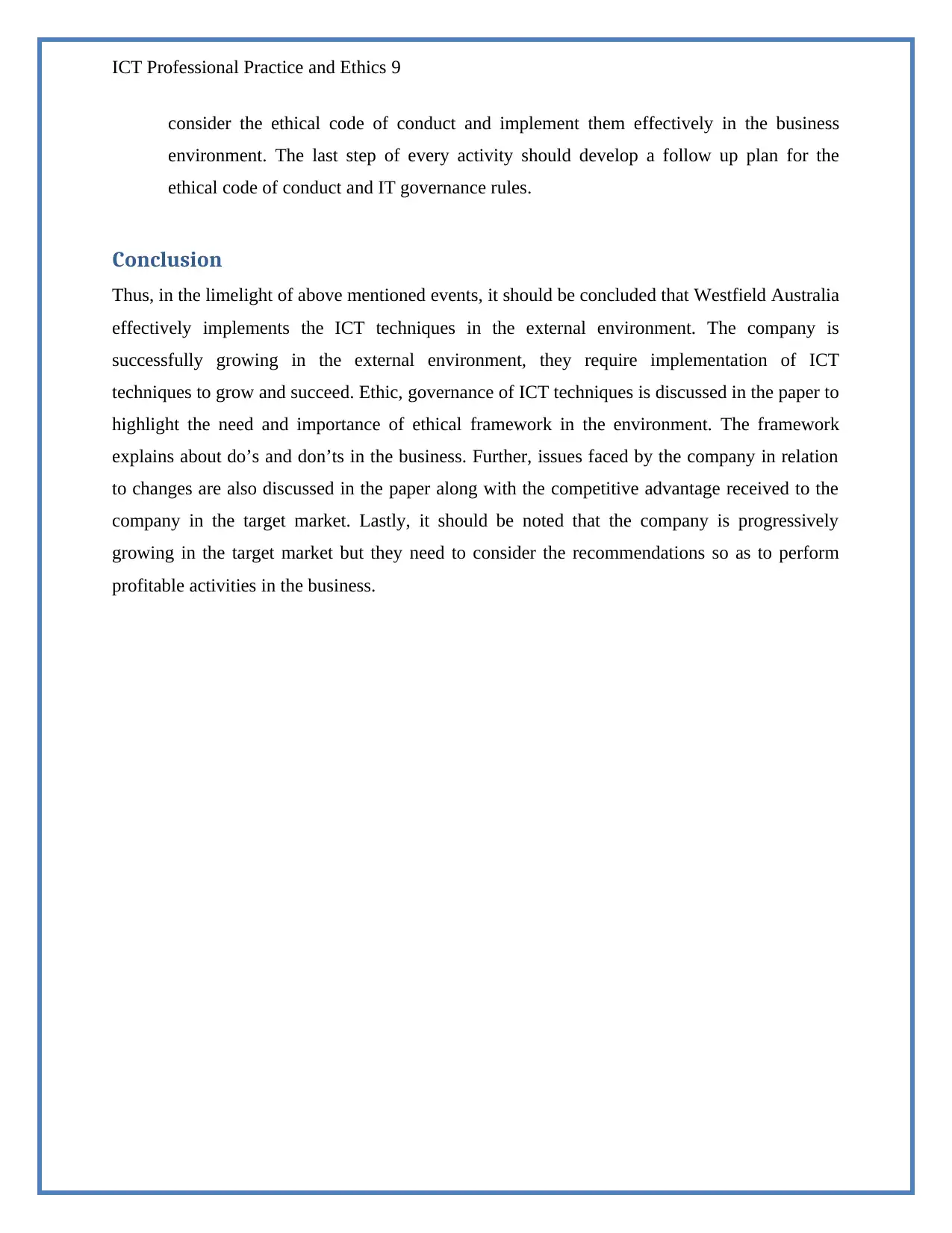
ICT Professional Practice and Ethics 9
consider the ethical code of conduct and implement them effectively in the business
environment. The last step of every activity should develop a follow up plan for the
ethical code of conduct and IT governance rules.
Conclusion
Thus, in the limelight of above mentioned events, it should be concluded that Westfield Australia
effectively implements the ICT techniques in the external environment. The company is
successfully growing in the external environment, they require implementation of ICT
techniques to grow and succeed. Ethic, governance of ICT techniques is discussed in the paper to
highlight the need and importance of ethical framework in the environment. The framework
explains about do’s and don’ts in the business. Further, issues faced by the company in relation
to changes are also discussed in the paper along with the competitive advantage received to the
company in the target market. Lastly, it should be noted that the company is progressively
growing in the target market but they need to consider the recommendations so as to perform
profitable activities in the business.
consider the ethical code of conduct and implement them effectively in the business
environment. The last step of every activity should develop a follow up plan for the
ethical code of conduct and IT governance rules.
Conclusion
Thus, in the limelight of above mentioned events, it should be concluded that Westfield Australia
effectively implements the ICT techniques in the external environment. The company is
successfully growing in the external environment, they require implementation of ICT
techniques to grow and succeed. Ethic, governance of ICT techniques is discussed in the paper to
highlight the need and importance of ethical framework in the environment. The framework
explains about do’s and don’ts in the business. Further, issues faced by the company in relation
to changes are also discussed in the paper along with the competitive advantage received to the
company in the target market. Lastly, it should be noted that the company is progressively
growing in the target market but they need to consider the recommendations so as to perform
profitable activities in the business.
Paraphrase This Document
Need a fresh take? Get an instant paraphrase of this document with our AI Paraphraser
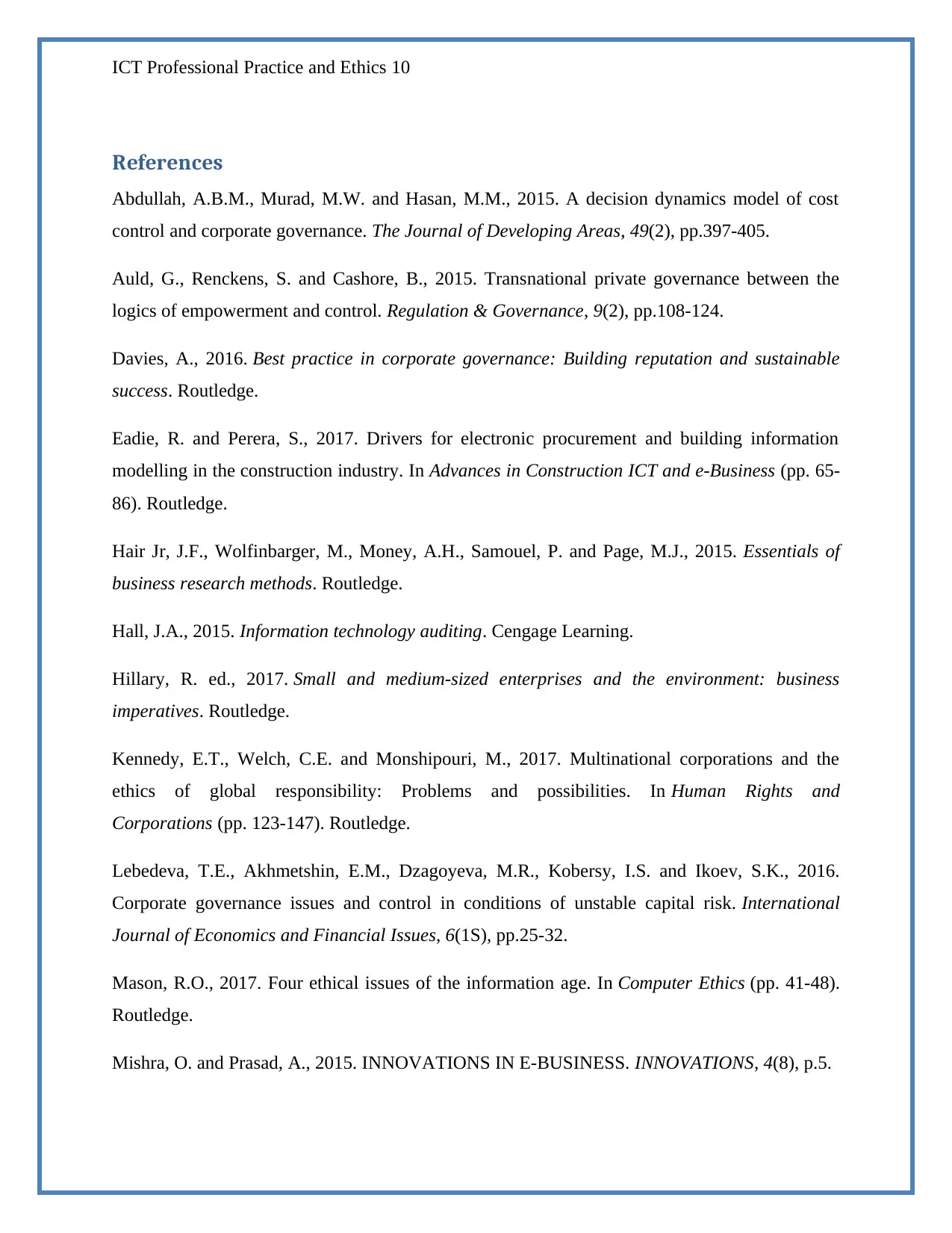
ICT Professional Practice and Ethics 10
References
Abdullah, A.B.M., Murad, M.W. and Hasan, M.M., 2015. A decision dynamics model of cost
control and corporate governance. The Journal of Developing Areas, 49(2), pp.397-405.
Auld, G., Renckens, S. and Cashore, B., 2015. Transnational private governance between the
logics of empowerment and control. Regulation & Governance, 9(2), pp.108-124.
Davies, A., 2016. Best practice in corporate governance: Building reputation and sustainable
success. Routledge.
Eadie, R. and Perera, S., 2017. Drivers for electronic procurement and building information
modelling in the construction industry. In Advances in Construction ICT and e-Business (pp. 65-
86). Routledge.
Hair Jr, J.F., Wolfinbarger, M., Money, A.H., Samouel, P. and Page, M.J., 2015. Essentials of
business research methods. Routledge.
Hall, J.A., 2015. Information technology auditing. Cengage Learning.
Hillary, R. ed., 2017. Small and medium-sized enterprises and the environment: business
imperatives. Routledge.
Kennedy, E.T., Welch, C.E. and Monshipouri, M., 2017. Multinational corporations and the
ethics of global responsibility: Problems and possibilities. In Human Rights and
Corporations (pp. 123-147). Routledge.
Lebedeva, T.E., Akhmetshin, E.M., Dzagoyeva, M.R., Kobersy, I.S. and Ikoev, S.K., 2016.
Corporate governance issues and control in conditions of unstable capital risk. International
Journal of Economics and Financial Issues, 6(1S), pp.25-32.
Mason, R.O., 2017. Four ethical issues of the information age. In Computer Ethics (pp. 41-48).
Routledge.
Mishra, O. and Prasad, A., 2015. INNOVATIONS IN E-BUSINESS. INNOVATIONS, 4(8), p.5.
References
Abdullah, A.B.M., Murad, M.W. and Hasan, M.M., 2015. A decision dynamics model of cost
control and corporate governance. The Journal of Developing Areas, 49(2), pp.397-405.
Auld, G., Renckens, S. and Cashore, B., 2015. Transnational private governance between the
logics of empowerment and control. Regulation & Governance, 9(2), pp.108-124.
Davies, A., 2016. Best practice in corporate governance: Building reputation and sustainable
success. Routledge.
Eadie, R. and Perera, S., 2017. Drivers for electronic procurement and building information
modelling in the construction industry. In Advances in Construction ICT and e-Business (pp. 65-
86). Routledge.
Hair Jr, J.F., Wolfinbarger, M., Money, A.H., Samouel, P. and Page, M.J., 2015. Essentials of
business research methods. Routledge.
Hall, J.A., 2015. Information technology auditing. Cengage Learning.
Hillary, R. ed., 2017. Small and medium-sized enterprises and the environment: business
imperatives. Routledge.
Kennedy, E.T., Welch, C.E. and Monshipouri, M., 2017. Multinational corporations and the
ethics of global responsibility: Problems and possibilities. In Human Rights and
Corporations (pp. 123-147). Routledge.
Lebedeva, T.E., Akhmetshin, E.M., Dzagoyeva, M.R., Kobersy, I.S. and Ikoev, S.K., 2016.
Corporate governance issues and control in conditions of unstable capital risk. International
Journal of Economics and Financial Issues, 6(1S), pp.25-32.
Mason, R.O., 2017. Four ethical issues of the information age. In Computer Ethics (pp. 41-48).
Routledge.
Mishra, O. and Prasad, A., 2015. INNOVATIONS IN E-BUSINESS. INNOVATIONS, 4(8), p.5.
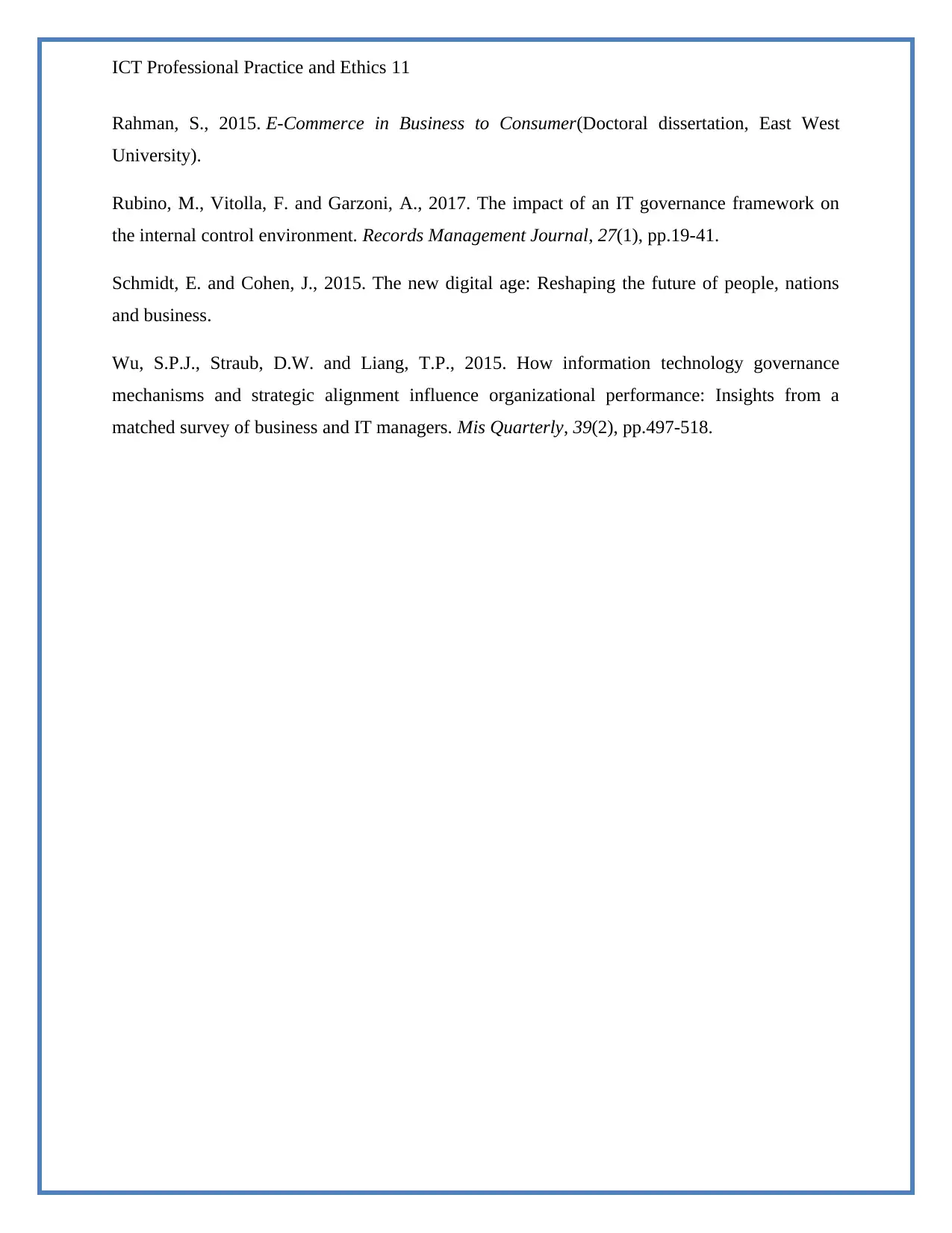
ICT Professional Practice and Ethics 11
Rahman, S., 2015. E-Commerce in Business to Consumer(Doctoral dissertation, East West
University).
Rubino, M., Vitolla, F. and Garzoni, A., 2017. The impact of an IT governance framework on
the internal control environment. Records Management Journal, 27(1), pp.19-41.
Schmidt, E. and Cohen, J., 2015. The new digital age: Reshaping the future of people, nations
and business.
Wu, S.P.J., Straub, D.W. and Liang, T.P., 2015. How information technology governance
mechanisms and strategic alignment influence organizational performance: Insights from a
matched survey of business and IT managers. Mis Quarterly, 39(2), pp.497-518.
Rahman, S., 2015. E-Commerce in Business to Consumer(Doctoral dissertation, East West
University).
Rubino, M., Vitolla, F. and Garzoni, A., 2017. The impact of an IT governance framework on
the internal control environment. Records Management Journal, 27(1), pp.19-41.
Schmidt, E. and Cohen, J., 2015. The new digital age: Reshaping the future of people, nations
and business.
Wu, S.P.J., Straub, D.W. and Liang, T.P., 2015. How information technology governance
mechanisms and strategic alignment influence organizational performance: Insights from a
matched survey of business and IT managers. Mis Quarterly, 39(2), pp.497-518.
⊘ This is a preview!⊘
Do you want full access?
Subscribe today to unlock all pages.

Trusted by 1+ million students worldwide
1 out of 12
Related Documents
Your All-in-One AI-Powered Toolkit for Academic Success.
+13062052269
info@desklib.com
Available 24*7 on WhatsApp / Email
![[object Object]](/_next/static/media/star-bottom.7253800d.svg)
Unlock your academic potential
Copyright © 2020–2025 A2Z Services. All Rights Reserved. Developed and managed by ZUCOL.





